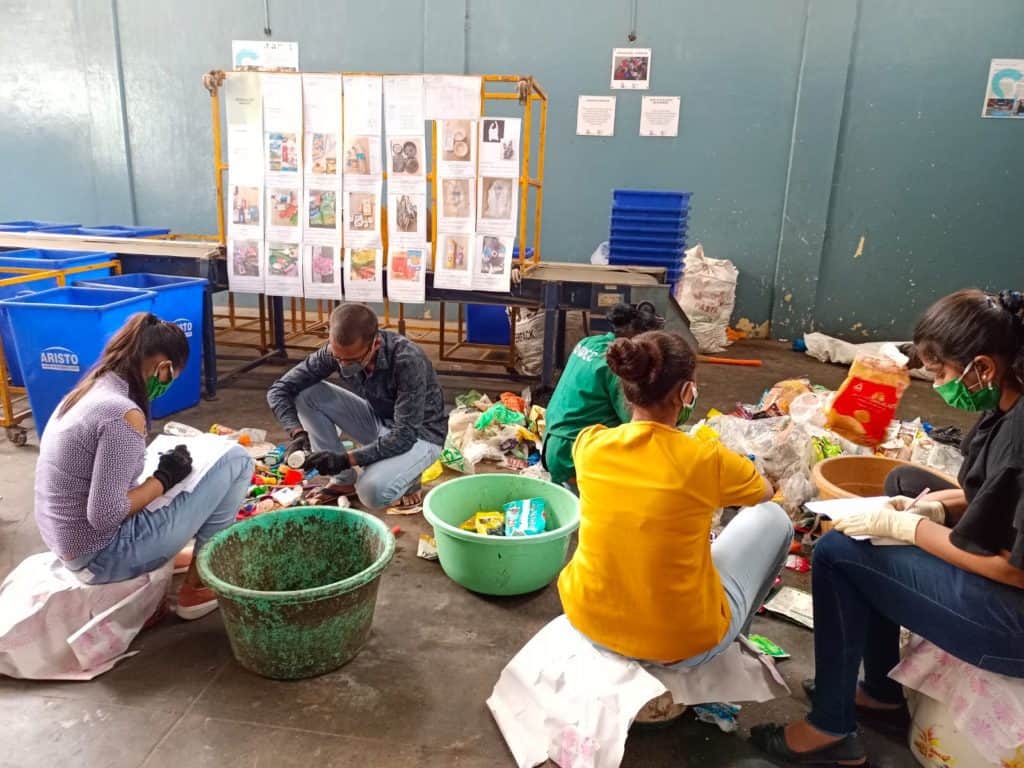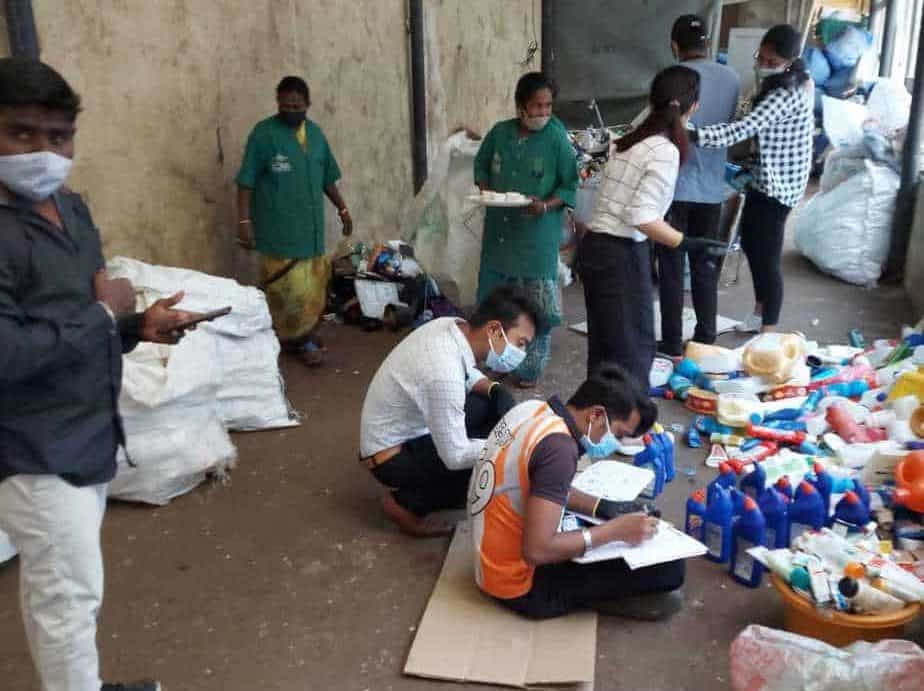In Bengaluru, more than two-thirds of plastic waste comprise household products like personal care and food packaging, dominated by milk packaging (KMF, Dodla, Heritage, Milk Mist etc.), which contributes a big chunk of such waste.
The use of plastic packaging material has increased over the years particularly with the growth of e-com companies, with Amazon leading the list. Among product companies, the leading brands which use a lot of plastic material to package their products include Unilever, Coca Cola, Reckitt Benckiser, ITC and Britannia.
These are the findings from a plastic brand audit exercise, conducted in September 2021. Hasiru Dala did the final analysis of the audit report with help from the Solid Waste Management Round Table (SWMRT).
The audit itself was designed and developed by Break Free from Plastics (BFFP), a global movement envisioning a future free from plastic pollution. There are broadly two types of brand audits, home audits and clean up drives. The data collected from home audits reflect the composition of household plastic waste generations.
Read more: Seven policy measures needed to beat plastic pollution in our cities
Various city-based organisations such as Hasiru Dala Innovations, The Anonymous Indian Charitable Trust, Stone Soup, Beautiful Bengaluru, Bangalore Apartment Federation, Clean Coorg Initiative, volunteer groups and students from Acharya Bangalore B School, Good Earth, Padmashree School of Public Health got together to conduct this brand audit in 44 locations across several locations in Bengaluru, Bettahalasur Gram Panchayat located north of Bengaluru, Coorg and Mysuru.
Over 288 volunteers audited over 1,24,390 pieces of plastic packaging over three days, from home audits. Bengaluru tabulated the maximum waste with 74,616 pieces.
In Bengaluru, the audit was done in six Dry Waste Collection Centres (DWCCs)—-Ward 177 JP Nagar, Ward 150 Sarjapur, Ward 195 Gottigere, Ward 112 Domlur, Ward 44 Marappanpalya and Ward 151 Koramangala. And in apartments like Springfields, Whitehouse Apartments, GoodEarth, Westend Heights, Raheja Residency, Ajmera Greens and Skywood Apartment.

Read more: Plastic waste: Why EPR alone doesn’t stand a chance
What the audit revealed
The 1,24,390 pieces of plastic waste audited showed 2663 brands.
- National brands dominated the list accounting for 73% of the waste, with international brands contributing about 27%.
- Unbranded products accounted for 31% of the total pieces, and this includes single use plastic items like plastic bags, covers and pouches including those for dustbins, food packaging such as chapati covers, snacks etc.
- The top International Brands overall were Pepsi, Coca Cola, Unilever, Nestle, Mondelez, Reckitt Benckiser and Amazon.
- The top local/national brands overall were Karnataka Milk Federation Limited, Nandini, Bisleri, Parle, ITC, Marico, Himalaya, Sipon, Dodla, United Spirits, Haldiram, Heritage, Paper Boat, MTR, Patanjali, John Distilleries (Original Choice), Milky Mist Dairy Food and MK Agrotech Pvt Ltd (Sun Pure Oil).
- Over 59.6% of the plastic items audited were food packaging, followed by other packaging materials at 19.9%.
- In terms of material type, low density polyethylene (LDPE) was the highest with 33%, with milk and curd items accounting for the bulk of it, followed by unknown, unidentifiable or multi layer plastics and category 7 plastics (composites made from multiple types of plastic) at 30.6% and included biscuit packets, chocolate wrappers, shampoo packets, sachets, masks, and tetra packs.
- Nearly three-fourth of the material was single-layer material i.e., 90688 pieces (73%).
- In Bengaluru, food packaging dominated the list with 60%, followed by other packaging material at 18%. Household products and personal care was third highest at 8% . Among food packaging, milk packaging (KMF, Dodla, Heritage, Milk Mist were in the top 20 category) followed by delivery packaging material with Amazon leading the list. In Bettahalasur, a little more than half of the pieces were food packaging with 55%, followed by packaging material 21%. Among all the four cities in the smoking materials category Bettahalasur had the highest with 55%, brands such ITC, Imperial Brand and Philip Morris International (Altria Group) tops the list of smoking materials. Other popular brands of tobacco products included Badshah Masala (by Jhaveri Industries), Swagat Gold (raw tobacco), Star Pan Masala and Preet Bidi.
- The other national/local brands in the top five in Bettahalasur included Parle, ITC, Dodla, Britannia and DMart and among international brands, Unilever, Pepsi and Modelez were in the top three.
- In Coorg, food packing was maximum with 63% and followed by packaging material about one-fourth. Among the packaging material Coorg had the highest among the four audited cities with 25%, with most of the material being unbranded and plastic covers. Coorg was the second highest in food packaging with 63% with milk packaging and alcohol packaging topping the list (United Spirits and John Distilleries figured in the top 10) as compared to other cities. The top international brand was Pepsi and the top national brands were KMF-Nandini, Sipon, Parle, United Spirits, Bisleri.
- In Mysore, little more than half of the waste was food packing (52%) followed by other materials that included sachets, chips packets etc. Among all the cities in the Personal care category Mysore was least with 2.9 %, whereas within Mysore city personal care was around 11% which was highest as compared to Bengaluru, Bettahalasur and Coorg that included products such as shampoos, soaps, hair dye/colour, and diapers were popular items with CavinKare and Unilever being the leading brands. Other popular brands included Chik shampoo, Meera Shampoo, Indica hair dye, Lifebuoy, Ponds, Huggies, and Santoor (Wipro). Other top national brands contributing to increasing plastic waste included ITC, Parle, Govardhan, Britannia and United Spirits. The top international brands were Nestle, Pepsi, Mondelez.

“The brand audit was an eye-opening experience,” says Madhuri Mandava, Co-founder, Paani Earth “We all felt that we were doing our bit for the environment, that we were recycling. It was shocking that we found carry bags and multilayer plastics. Working with student volunteers is also an interesting experience. The resulting conversations drive home the point that while plastics have their uses, some of them are quite unnecessary. The younger children who participated also pledged to never buy certain chips packets, because of the type of packaging used.”
Echoing Madhuri’s statement, Shakila Banu, Member, Women of Wisdom and Founder, Sachetan says: “The exercise offered an interesting insight into consumer buying behaviour, and the so many various different categories of packaging.”

What do all these numbers tell us
According to Nirmala Shekar, Project Manager, Hasiru Dala: “Given that unbranded products accounted for 31% of the total pieces audited, it implies that the pandemic has managed to dilute the Karnataka plastic ban”.
”The inclusion of doorstep delivery by e-commerce companies, packaging waste has added new streams of plastic waste,” adds Aparna Kumar, Volunteer Clean Coorg Initiative. “In addition to reinforcing the importance of segregation of waste at source, to identifying packaging by brands and being aware of unbranded packaging, the brand audit is an important tool for policymakers that needs to be replicated. We also realised that because of the existence of dry waste collection centres, we were able to conduct the brand audit from the door-to-door collection with ease. Without these centres, the bulk of the low-value waste and multilayer, multi-material packaging would never be accounted for by brands, as it mostly ends up being dumped or burnt”.
Mahesh Thimmaiah, Senior Environmental Officer, Karnataka State Pollution Control Board and Advisory Committee Member, Environmental Management and Policy Research Institute (EMPRI), said at the webinar hosted by Hasiru Dala and EMPRI on February 28th on the release of the audit report: “This report is enlightening, not just for regulators, but also the stakeholders. This exercise is worth replicating across Karnataka, given that the state has over 10,000 eco-clubs across different geographies. It will then be easy to estimate the total quantum of this kind of waste.
“Understanding who is contributing to the overall plastic waste generation, by type of material and brands and will help policymakers”.
With inputs from Nirmala Shekar, Beula Anthony and Bianca Fernandes from Hasiru Dala